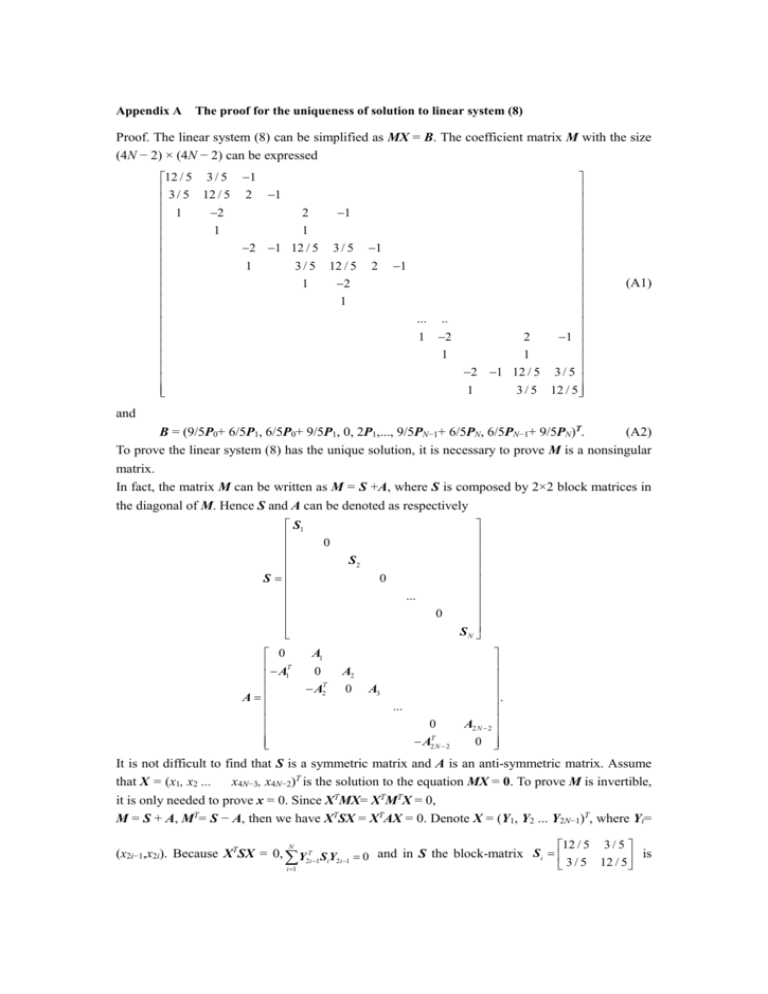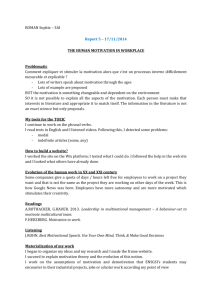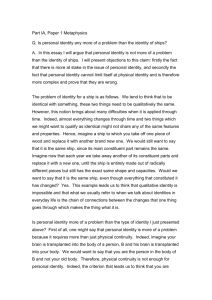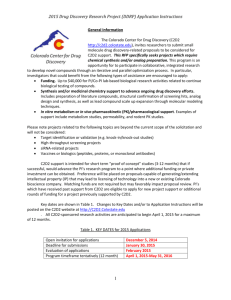Appendix A The proof for the uniqueness of solution to linear system
advertisement

Appendix A The proof for the uniqueness of solution to linear system (8) Proof. The linear system (8) can be simplified as MX = B. The coefficient matrix M with the size (4N − 2) × (4N − 2) can be expressed 12 / 5 3 / 5 1 3 / 5 12 / 5 2 1 1 2 2 1 1 1 2 1 12 / 5 3 / 5 1 1 3 / 5 12 / 5 2 1 1 2 1 ... .. 1 2 2 1 1 1 2 1 12 / 5 3 / 5 1 3 / 5 12 / 5 (A1) and B = (9/5P0+ 6/5P1, 6/5P0+ 9/5P1, 0, 2P1,..., 9/5PN−1+ 6/5PN, 6/5PN−1+ 9/5PN)T. (A2) To prove the linear system (8) has the unique solution, it is necessary to prove M is a nonsingular matrix. In fact, the matrix M can be written as M = S +A, where S is composed by 2×2 block matrices in the diagonal of M. Hence S and A can be denoted as respectively S1 S 0 AT 1 A 0 S2 0 ... 0 A1 0 A2 A2T 0 A3 ... 0 A2TN 2 S N . A2 N 2 0 It is not difficult to find that S is a symmetric matrix and A is an anti-symmetric matrix. Assume that X = (x1, x2 ... x4N−3, x4N−2)T is the solution to the equation MX = 0. To prove M is invertible, it is only needed to prove x = 0. Since XTMX= XTMTX = 0, M = S + A, MT= S − A, then we have XTSX = XTAX = 0. Denote X = (Y1, Y2 ... Y2N−1)T, where Yi= N 12 / 5 3/5 (x2i−1,x2i). Because XTSX = 0, Y2Ti1 SiY2i 1 0 and in S the block-matrix Si is 3 / 5 12 / 5 i 1 positive-definite, Y2Ti 1 SiY2i 1 0, thus Y2i-1=0 for i=1...N. Therefore X= (0, Y2, 0, Y4 ... Y2N−2, 0)T, SX = 0. On the other hand, MX = 0, thus AX = 0 which is equivalent to be A1 AT 2 A3 A4T A5 ... ... A2TN 4 Y2T T Y4 Y6T 0 A2 N 3 Y2TN 4 A2TN 2 Y2TN 2 The coefficient matrix of linear equation above is a block-diagonal matrix and Ai is nonsingular for any i, therefore Y2i = 0 for i = 1...N-1. Now it has been proved that X = 0. Therefore M is a nonsingular matrix. Appendix B The real solution to Eq.(10) Eq.(10) can be simplified to be a quintic equation F (u ) [( ri (u ) Pi ) ri(u )]( Pi 1 Pi ) 2 [(ri (u ) Pi ) ( Pi 1 Pi )] [ri(u ) ( Pi 1 Pi )] 0 (B1) From eq.(9), since Di(0) = Di(1) = 0, equation F(u) = 0 must have at least one real root on the open interval (0,1) and both sides of Eq.(B1) have two factors u and u simplified to be a cubic equation about unknown u having the following form au3+bu2+cu+d=0 (B2) where a (3bi Pi 3ai Pi 1 )2 ( Pi 1 Pi )2 [(3bi Pi 3ai Pi 1 ) ( Pi 1 Pi )]2 ; b [(3bi Pi 3ai Pi 1 ) (4 Pi 1 Pi 2bi 7ai )] ( Pi 1 Pi ) 2 [(3bi Pi 3ai Pi 1 ) ( Pi 1 Pi )] [(4 Pi 1 Pi 2bi 7ai ) ( Pi 1 Pi )]; c [(3bi Pi 3ai Pi 1 ) (2 Pi 1 Pi ai ) (2 Pi 1 Pi 3ai ) (2 Pi 1 2bi 4ai )] ( Pi 1 Pi ) 2 [(3bi Pi 3ai Pi 1 ) ( Pi 1 Pi )][(2 Pi 1 Pi ai ) ( Pi 1 Pi )] [(2 Pi 1 Pi 3ai ) ( Pi 1 Pi )] [(2 Pi 1 2bi 4ai ) ( Pi 1 Pi )]; d [(( Pi 1 Pi ) (2 Pi 1 2bi 4ai ) (2 Pi 1 Pi 3ai ) (ai Pi 1 ))] ( Pi 1 Pi ) 2 ( Pi 1 Pi ) 2 [(2 Pi 1 2bi 4ai ) (B3) ( Pi 1 Pi )] [(2 Pi 1 Pi 3ai ) ( Pi 1 Pi )] [(ai Pi 1 ) ( Pi 1 Pi )]. If a = 0, Eq. (B2) is a quadratic equation, we can use the formula for the root of quadratic equation ui c c 2 4bd . 2b and find that ones in the interval (0,1). Take the larger D(ui*) among the values as the chord error Erri. If a≠0, then the method of finding the real roots is given below. Let A = b2 ac, B = bc ad, C = c2 bd and ∆ = B2 AC. If A = B = 0, then Eq.(B2) has three repeated real roots ui1 ui 2 ui 3 b . 3a If ∆ > 0, then equation has only one real root ui b ( 3 Y1 3 Y2 ) 3a , where B B 2 4 AC Y1,2 Ab 3a 2 . If ∆ = 0 and A ≠ 0, then equation has three real roots ui1 b B B , ui 2 ui 3 . a A 2A If ∆ < 0, the equation has three different real roots ui1 b 2 A cos 3a arccos T , T 3,u i 2,i 3 b A cos 3 sin 3 3 , where 3a 2 Ab 3aB 2 A3 ( A 0, 1 T 1). Find all the real roots lying on the open interval (0,1) and select ui* such that D(ui*) is the largest one among all. Then at the segment Pi−1Pi, the chord error is Erri= D(ui*). Appendix C The proof of Theorem 1 Proof. By the property of G2 continuity, then c1d1 and d2c2 are coplanar. In fact, presume that c1d1|| aibi. Since c1, d1, c2, d2 are on OSQ by the property of G2 and OSQ ∩ OSi = c2d2, then c2d2||aibi. Besides, since the path is G2 at Pi−1 and Pi, it is known that c1d1 1 ai bi and c2d2 2 ai bi , where 1, 2> 0. Let d1Q t d1c2 . Hence from the Bezier segment ri1(u) between Pi−1 and Q, OQ ri1 (1) ri1 (1) d1c1 d1Q a b d c 21 i i 1 32 . 3 3 || ri1 (1) || || 3d1Q || t || 3d1c2 || From Bezier segment ri2(u) between Q and Pi, (C1) OQ ri2 (0) ri2 (0) c2 d 2 Qc2 2 ai bi d1c2 . 3 3 || ri2 (0) || || 3Qc2 || (1 t ) 2 || 3d1c2 ||3 (C2) Therefore for the general case (the control polygon Pi−1aibiPi is spatial), we have OQ OQ for any 1, 2, t. That deducts the contradiction that the transitional curve at Q has no G2 continuity. Hence it is proved that the new ridge line c1d1 must intersect the old ridge line aibi. Similarly we can conclude that d2c2 must intersect aibi. For the case that Pi−1ai and Pibi are skew lines. Claim that c1d1 ∦c2d2. In fact, since c1d1 and d2c2 intersect aibi, OSi−1 and OSi coincide if c1d1||c2d2. This contradicts that Pi−1ai and Pibi are skew lines. Let e1 be the intersection point of c1d1 and aibi, and e2 be the intersection point of d2c2 and aibi. Assume e1≠e2. Since e1e2 in the plane OSQ, line aibi is on the plane OSQ. Thus ai, bi ∈ OSQ. On the other hand, c1, d1, c2, d2∈OSQ, hence c1ai∈OSQ. That is Pi−1ai∈OSQ. Similarly we can know that Pibi ∈OSQ. This contradicts Pi−1ai and Pibi are skew lines. Hence e1= e2. Appendix D The proof of Theorem 2 Before proving Theorem 2, note there is an important equivalent condition for G2 continuity [16]. Theorem 3. [Equivalent condition of G2 continuity] The parametric curve r(u) is G2 if and only if both the vectors T and T N are continuous, where T is the unit tangent vector, N is the unit normal vector and κ is curvature magnitude along the curve r(u). The proof of Theorem 2: Proof. For G2 continuity at Pi−1, since the curvature vector of the path at Pi−1 is κ( Pi 1 ) κi (0), by the equivalent condition of G2 continuity, c1d1 Pi 1c1 3 || Pi 1c1 || ai bi Pi 1ai || Pi 1ai ||3 . Since c1d1 k4 c1e k4 (1 k1 ) Pi 1ai k3k4 ai bi , the sufficient and necessary condition for G2 continuity at Pi−1 is k22=k3k4. (D1) Similarly for continuity at Pi−1, it can be obtained that the sufficient and necessary condition 2 for G continuity at Pi is k22= (1 − k3)k5. (D2) 2 For G continuity at Q, then G2 c2 d 2 Qc2 3 || Qc2 || d1c1 d1Q || d1Q ||3 Since Qc2 (1 k6 )d1c2 (1 k6 )[(1 k4 )c1e (1 k5 )ed2 ] . and d1Q k6 d1c2 k6 [(1 k4 )c1e (1 k5 )ed2 ], then it is easy to obtain that the sufficient and necessary condition for G2 continuity at Q is k5 (1 k4 ) (1 k6 ) 2 k4 (1 k5 ) k62 . (D3)










